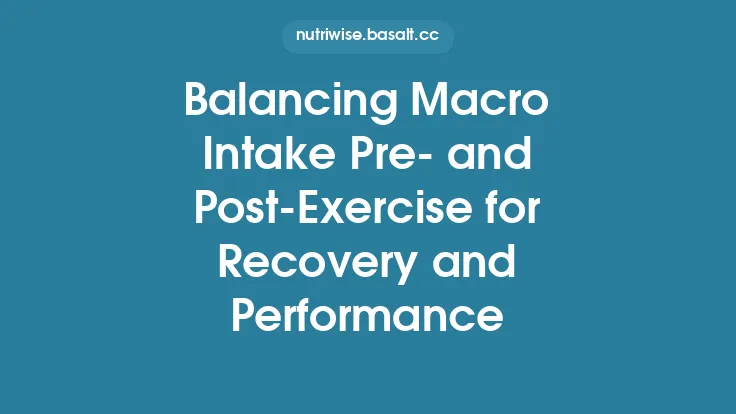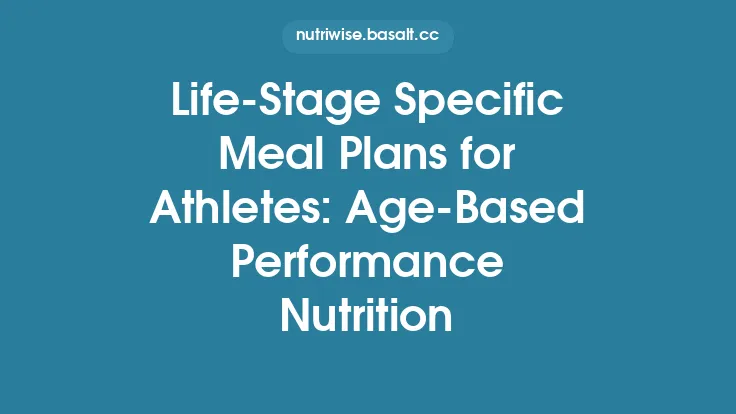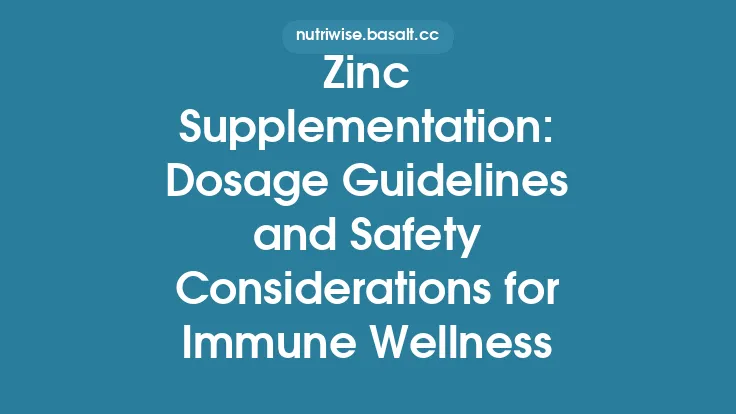Adolescence is a period of rapid growth, hormonal flux, and evolving identity, but for teen athletes the stakes are even higher. The combination of intense training schedules, competition pressures, and the natural demands of a developing body creates a unique nutritional landscape. While macronutrients (carbohydrates, protein, and fats) often dominate the conversation around sports performance, micronutrients—vitamins and minerals required in small amounts—play equally critical roles in energy production, muscle contraction, immune defense, bone health, and recovery. Optimizing micronutrient intake can mean the difference between plateauing, thriving, or succumbing to injury and burnout.
Below is a comprehensive, evergreen guide that translates the science of micronutrients into practical, age‑appropriate recommendations for teen athletes (typically ages 13‑19). The focus is on performance enhancement, injury prevention, and efficient recovery, with attention to sport‑specific demands, gender considerations, and real‑world eating patterns.
1. Why Micronutrients Matter for Teen Athletes
| Function | Key Micronutrients | Impact on Athletic Performance |
|---|---|---|
| Energy Metabolism | B‑vitamins (B1, B2, B3, B6, B12, Folate), Magnesium, Iron | Facilitate carbohydrate, fat, and protein oxidation; support ATP synthesis. |
| Oxygen Transport & Utilization | Iron, Copper, Vitamin B12, Folate | Hemoglobin synthesis, myoglobin function, and mitochondrial efficiency. |
| Muscle Contraction & Recovery | Calcium, Magnesium, Potassium, Sodium, Vitamin D | Regulate excitation‑contraction coupling, prevent cramps, support protein synthesis. |
| Bone Development & Strength | Calcium, Vitamin D, Vitamin K2, Phosphorus, Magnesium | Critical during peak bone mass accrual (13‑19 y). |
| Immune Function & Inflammation Control | Vitamin C, Vitamin D, Zinc, Selenium, Vitamin E | Reduce infection risk, modulate post‑exercise inflammation. |
| Antioxidant Defense | Vitamins C & E, Selenium, Beta‑carotene, Polyphenols | Counteract oxidative stress from high‑intensity training. |
| Hormonal Balance | Vitamin D, Zinc, Iodine | Influence testosterone, growth hormone, and thyroid hormones that affect muscle growth and metabolism. |
Because teen athletes are simultaneously growing and training, any shortfall can impair both developmental processes and sport‑specific outcomes.
2. Core Micronutrient Recommendations (13‑19 y)
The Recommended Dietary Allowances (RDAs) for adolescents provide a baseline, but athletes often need to aim toward the upper end of the range—or slightly beyond—depending on training volume, sport type, and individual factors (e.g., menstrual status, injury history). The table below aligns RDAs with sport‑adjusted targets.
| Micronutrient | RDA (Adolescents) | Athlete Target* | Primary Food Sources | Notes for Teen Athletes |
|---|---|---|---|---|
| Vitamin A (RAE) | 600 µg (M), 500 µg (F) | 600‑800 µg | Sweet potatoes, carrots, spinach, fortified dairy | Supports vision and immune health; excess can be toxic—avoid mega‑doses. |
| Vitamin C | 75 mg (M), 65 mg (F) | 100‑200 mg | Citrus, berries, bell peppers, kiwi | Enhances collagen synthesis for tendon health; high doses (>1 g) may increase oxidative stress post‑exercise. |
| Vitamin D | 600 IU (M/F) | 800‑2000 IU (or 20‑50 µg) | Sunlight, fortified milk, fatty fish, eggs | Crucial for calcium absorption; deficiency common in indoor athletes—consider testing serum 25(OH)D. |
| Vitamin E (α‑tocopherol) | 15 mg | 15‑30 mg | Nuts, seeds, vegetable oils, spinach | Antioxidant; high doses (>400 IU) may impair training adaptations. |
| Vitamin K2 | 75 µg (M), 60 µg (F) | 90‑120 µg | Natto, hard cheeses, fermented soy | Works with Vitamin D for bone mineralization. |
| Thiamin (B1) | 1.2 mg (M), 1.0 mg (F) | 1.2‑1.5 mg | Whole grains, pork, legumes | Energy metabolism; deficiency rare but can affect endurance. |
| Riboflavin (B2) | 1.3 mg (M), 1.1 mg (F) | 1.3‑1.6 mg | Dairy, eggs, almonds, leafy greens | Supports redox reactions. |
| Niacin (B3) | 16 mg (M), 14 mg (F) | 16‑20 mg | Poultry, fish, peanuts, whole grains | Energy production; high doses may cause flushing. |
| Vitamin B6 | 1.3 mg | 1.5‑2.0 mg | Bananas, chickpeas, fish, potatoes | Amino acid metabolism; excess (>100 mg) neurotoxic. |
| Folate | 400 µg DFE | 400‑600 µg DFE | Leafy greens, legumes, fortified grains | DNA synthesis; especially important for female athletes to prevent anemia. |
| Vitamin B12 | 2.4 µg | 2.5‑4 µg | Meat, fish, dairy, fortified cereals | Red blood cell formation; vegans may need supplementation. |
| Calcium | 1300 mg (M/F) | 1300‑1500 mg | Dairy, fortified plant milks, sardines, kale | Peak bone mass accrual; split doses for better absorption. |
| Magnesium | 410 mg (M), 360 mg (F) | 400‑500 mg | Nuts, seeds, whole grains, legumes | Muscle relaxation, electrolyte balance; high doses cause GI upset. |
| Phosphorus | 1250 mg | 1250‑1500 mg | Meat, dairy, nuts, beans | Works with calcium for bone health. |
| Iron | 11 mg (M), 15 mg (F) | 15‑20 mg (F), 12‑15 mg (M) | Red meat, poultry, beans, fortified cereals | Female athletes at higher risk due to menstruation; monitor ferritin. |
| Zinc | 11 mg (M), 9 mg (F) | 12‑15 mg | Oysters, beef, pumpkin seeds, chickpeas | Immune function, testosterone synthesis; excess impairs copper absorption. |
| Copper | 0.9 mg | 1.0‑1.5 mg | Shellfish, nuts, whole grains | Iron metabolism; deficiency rare. |
| Selenium | 55 µg | 55‑70 µg | Brazil nuts, fish, eggs | Antioxidant enzyme (GPx) cofactor. |
| Potassium | 4700 mg | 4700‑5500 mg | Bananas, potatoes, beans, yogurt | Prevents cramping, supports fluid balance. |
| Sodium | 1500 mg (AI) | 1500‑3000 mg (adjust for sweat loss) | Table salt, processed foods, sports drinks | Essential for nerve transmission; replace losses after heavy sweating. |
| Iodine | 150 µg | 150‑200 µg | Seaweed, dairy, iodized salt | Thyroid hormone production; important for metabolism. |
\*Athlete Target reflects the upper end of the RDA or modestly higher, based on current sports nutrition literature. Individual needs may vary; professional assessment (e.g., dietitian, sports physician) is recommended for precise tailoring.
3. Sport‑Specific Micronutrient Priorities
3.1 Endurance Sports (e.g., cross‑country, swimming, rowing)
- Iron & Copper: High oxidative turnover and potential gastrointestinal blood loss increase iron requirements. Monitor ferritin every 6‑12 months.
- B‑Vitamins: Support sustained carbohydrate oxidation; consider a B‑complex supplement if dietary intake is low.
- Electrolytes (Sodium, Potassium, Magnesium): Prolonged sweating leads to significant losses; replace via electrolyte‑rich fluids and foods.
- Antioxidants (Vitamin C, E, Selenium): May help mitigate oxidative stress, but avoid mega‑doses that could blunt training adaptations.
3.2 Power & Strength Sports (e.g., weightlifting, football, gymnastics)
- Vitamin D & Calcium: Critical for neuromuscular function and bone strength; deficiency raises fracture risk.
- Zinc & Magnesium: Support testosterone production, protein synthesis, and muscle relaxation.
- Vitamin K2: Works synergistically with calcium and vitamin D to direct calcium to bone rather than soft tissue.
- Creatine & Phosphocreatine Pathway: While not a micronutrient, adequate riboflavin (B2) supports the enzymatic steps of creatine synthesis.
3.3 Team Sports with Intermittent High‑Intensity Efforts (e.g., soccer, basketball, hockey)
- Iron & B‑Vitamins: For rapid ATP turnover during sprints.
- Electrolytes: Frequent high‑intensity bursts increase sweat loss; replace during halftime or practice breaks.
- Vitamin C & E: Aid in recovery of connective tissue after repeated cutting and jumping.
3.4 Aesthetic & Weight‑Sensitive Sports (e.g., gymnastics, figure skating, diving)
- Iron & Folate: Prevent anemia that can impair endurance and cognition.
- Calcium & Vitamin D: Counteract potential low‑energy availability that jeopardizes bone health.
- Zinc: Supports immune function during periods of caloric restriction.
4. Timing and Distribution of Micronutrients
- Spread Calcium & Vitamin D Across Meals: Calcium absorption is optimized when intake is ≤500 mg per sitting. Pair with vitamin D‑rich foods or a modest supplement.
- Iron with Vitamin C, Avoid Calcium: Consume iron‑rich foods (e.g., lean meat) alongside vitamin C sources (citrus, strawberries) to boost absorption. Avoid dairy or calcium supplements within 2 hours of iron intake.
- Pre‑Exercise Electrolyte Loading: For sessions >90 minutes or in hot environments, ingest a beverage containing 300‑600 mg sodium and 100‑200 mg potassium 30‑60 minutes before activity.
- Post‑Exercise Micronutrient Replenishment: A recovery snack that includes protein, carbohydrates, and a source of magnesium, zinc, and vitamin C (e.g., Greek yogurt with berries and a sprinkle of pumpkin seeds) supports glycogen restoration and muscle repair.
- Evening Vitamin D: Some evidence suggests that taking vitamin D with the largest meal of the day (often dinner) improves absorption due to higher dietary fat content.
5. Practical Meal Planning Strategies
5.1 Sample One‑Day Menu for a 16‑Year‑Old Female Soccer Player (≈2500 kcal)
| Meal | Foods (≈Micronutrient Highlights) |
|---|---|
| Breakfast | Oatmeal cooked in fortified soy milk (Calcium, Vitamin D, B12) + sliced banana (Potassium, Vitamin B6) + 1 tbsp chia seeds (Magnesium, Selenium) |
| Mid‑Morning Snack | Greek yogurt (Calcium, Vitamin B2) + mixed berries (Vitamin C, Antioxidants) |
| Lunch | Grilled chicken breast (Iron, Zinc) + quinoa salad with kale, cherry tomatoes, and roasted chickpeas (Calcium, Magnesium, Folate) + olive‑oil dressing (Vitamin E) |
| Afternoon Pre‑Practice Snack | Whole‑grain toast with almond butter (Magnesium, Vitamin E) + orange slices (Vitamin C) |
| Post‑Practice Recovery | Chocolate milk (Calcium, Vitamin D, Carbohydrates) + a small handful of dried apricots (Iron, Potassium) |
| Dinner | Baked salmon (Vitamin D, Selenium) + sweet potato mash (Vitamin A, Potassium) + steamed broccoli (Calcium, Vitamin K) |
| Evening Snack | Cottage cheese (Calcium, B12) + a few walnuts (Magnesium, Omega‑3) |
*Adjust portion sizes to meet individual energy needs.*
5.2 Quick “Micronutrient Boost” Snacks
| Goal | Snack | Micronutrient Profile |
|---|---|---|
| Iron & Vitamin C | Beef jerky + orange wedges | Iron, Vitamin C |
| Calcium & Vitamin D | Fortified plant‑based yogurt + chia seeds | Calcium, Vitamin D, Magnesium |
| Electrolyte Replenishment | Coconut water + a pinch of sea salt + banana | Potassium, Sodium, Magnesium |
| Antioxidant Recovery | Dark chocolate (≥70 % cacao) + strawberries | Vitamin C, Selenium, Polyphenols |
| Zinc & Immune Support | Pumpkin seed trail mix + dried figs | Zinc, Copper, Iron |
6. Supplementation: When Is It Necessary?
| Micronutrient | Indications for Supplementation | Recommended Form & Dose | Cautions |
|---|---|---|---|
| Vitamin D | Limited sun exposure, indoor training, serum 25(OH)D <30 ng/mL | Vitamin D3 1000‑2000 IU daily (adjust based on labs) | Monitor serum levels; avoid >4000 IU without supervision. |
| Iron | Ferritin <30 µg/L, symptomatic anemia, heavy menstrual losses | Ferrous sulfate 18 mg elemental iron 1–2×/day with vitamin C; consider low‑dose (≤30 mg) to reduce GI upset | Re‑check ferritin after 8‑12 weeks; avoid excess (>45 mg/day) to prevent oxidative damage. |
| Calcium | Low dietary intake, lactose intolerance | Calcium citrate 500 mg (split doses) | Do not exceed 2500 mg/day; avoid taking with iron. |
| Magnesium | Muscle cramps, high sweat loss, low dietary intake | Magnesium glycinate 200‑300 mg before bedtime | Excess can cause diarrhea; stay ≤350 mg supplemental. |
| Zinc | Poor intake, frequent infections, low growth velocity | Zinc gluconate 15 mg daily (max 40 mg) | High doses impair copper absorption; avoid with iron supplements. |
| B‑Complex | Vegetarian/vegan diet, high training volume, fatigue | Balanced B‑complex (B1 1.5 mg, B2 1.7 mg, B3 20 mg, B6 2 mg, B12 2.5 µg, Folate 400 µg) | Avoid mega‑doses of niacin (>35 mg) to prevent flushing. |
| Electrolyte Powders | Long training sessions (>2 h), hot climates | Sodium 300‑600 mg, Potassium 100‑200 mg per serving | Do not exceed 2 g sodium per hour; watch for hypertension risk. |
Key Takeaway: Whole foods should remain the primary source of micronutrients. Supplements are useful for filling gaps, correcting deficiencies, or meeting the heightened demands of intense training, but they must be used judiciously and preferably under professional guidance.
7. Monitoring and Assessment
- Baseline Blood Work (annually or bi‑annually):
- Serum ferritin, hemoglobin, hematocrit (iron status)
- 25‑hydroxyvitamin D (vitamin D status)
- Calcium, magnesium, and phosphorus (if clinically indicated)
- Thyroid panel (TSH, free T4) for athletes with unexplained fatigue.
- Dietary Tracking:
- Use a validated app (e.g., MyFitnessPal, Cronometer) to log 3‑day food records, focusing on micronutrient totals.
- Compare intake against the athlete target table above.
- Performance & Recovery Metrics:
- Track subjective measures (energy levels, muscle soreness, sleep quality).
- Objective markers: time‑to‑exhaustion tests, sprint times, strength outputs.
- Correlate dips in performance with potential micronutrient shortfalls.
- Injury Surveillance:
- Higher rates of stress fractures, muscle strains, or infections may signal deficiencies in calcium, vitamin D, zinc, or vitamin C.
- Adjustments:
- If ferritin <30 µg/L, increase iron intake and consider supplementation.
- If 25‑OH vitamin D <30 ng/mL, raise vitamin D dose and increase safe sun exposure.
- Re‑evaluate after 8‑12 weeks of any supplementation.
8. Special Considerations
8.1 Female Athletes and Menstrual Health
- Iron: Menstruating athletes lose 0.5‑2 mg of iron per day; ensure intake meets the higher target.
- Calcium & Vitamin D: Low energy availability can lead to menstrual disturbances and bone loss (Female Athlete Triad). Prioritize bone‑supporting micronutrients and consider a sports dietitian’s input.
8.2 Vegetarian and Vegan Athletes
- Vitamin B12: Must be obtained from fortified foods or supplements (≥2.5 µg/day).
- Iron & Zinc: Plant sources contain non‑heme iron and phytate‑bound zinc; enhance absorption with vitamin C and soaking/fermentation techniques.
- Calcium & Vitamin D: Use fortified plant milks and consider vitamin D2/D3 supplementation.
8.3 Athletes with Food Allergies or Intolerances
- Dairy-Free Calcium: Opt for fortified almond, soy, or oat milks; include leafy greens and tofu.
- Gluten-Free Iron: Emphasize lean meats, legumes, and gluten‑free fortified cereals.
- Allergen‑Free Electrolytes: Choose pure sea salt and natural fruit juices for potassium.
8.4 Travel and Competition Periods
- Portable Micronutrient Packs: Small packets of electrolyte powder, vitamin D drops, or iron‑rich snack bars can mitigate dietary disruptions.
- Hydration Planning: Use sweat‑rate testing to tailor sodium and potassium replacement during tournaments.
9. Putting It All Together: A Step‑by‑Step Action Plan
- Assess Current Status
- Schedule a blood panel and complete a 3‑day food log.
- Identify any red‑flag deficiencies (e.g., low ferritin, vitamin D <30 ng/mL).
- Set Micronutrient Targets
- Use the “Athlete Target” column as a benchmark.
- Adjust for individual factors (sex, sport, training load).
- Design a Food‑First Strategy
- Build weekly meal plans around nutrient‑dense foods listed in Section 5.
- Incorporate at least one “micronutrient boost” snack per day.
- Implement Targeted Supplementation (if needed)
- Choose evidence‑based products, follow dosing guidelines, and monitor for side effects.
- Monitor Progress
- Re‑test blood markers after 8‑12 weeks.
- Track performance metrics and recovery scores.
- Iterate
- Refine food choices, supplement doses, and timing based on data.
- Re‑assess annually or after major changes in training volume.
10. Frequently Asked Questions (FAQ)
Q1. Can I take a multivitamin instead of focusing on individual nutrients?
*Answer:* A high‑quality multivitamin can fill minor gaps, but it may not provide sufficient amounts of sport‑critical nutrients like iron, vitamin D, or calcium. Tailored supplementation based on lab results is more effective.
Q2. Are antioxidant supplements (e.g., high‑dose vitamin C/E) beneficial for recovery?
*Answer:* While antioxidants reduce oxidative stress, excessive doses can blunt training adaptations by interfering with cellular signaling. Aim for food‑based antioxidants and limit supplemental doses to ≤200 mg vitamin C and ≤400 IU vitamin E per day.
Q3. How much sodium is too much for a teen athlete?
*Answer:* The upper limit for adolescents is 2,300 mg/day. Athletes with heavy sweat losses may need up to 3,000 mg, but chronic excess can raise blood pressure. Balance intake with sweat loss assessments.
Q4. My coach says “carb loading” is all I need before a race—what about micronutrients?
*Answer:* Carbohydrate loading optimizes glycogen, but without adequate iron, vitamin D, and electrolytes, performance may still suffer. Include iron‑rich foods and electrolytes in pre‑event meals.
Q5. I’m a vegan athlete—do I need to worry about calcium?
*Answer:* Yes. Aim for 1300‑1500 mg calcium from fortified plant milks, tofu set with calcium sulfate, leafy greens, and consider a calcium citrate supplement if intake is insufficient.
11. Bottom Line
Teen athletes stand at the crossroads of rapid physiological development and demanding sport-specific stressors. Micronutrients are the silent architects that enable muscles to contract efficiently, bones to stay strong, the immune system to stay resilient, and the brain to stay sharp. By:
- Understanding the specific micronutrient roles,
- Aligning intake with sport‑specific demands,
- Timing nutrients around training and recovery,
- Using whole foods as the foundation and supplementing only when necessary,
- Regularly monitoring status through labs and performance metrics,
young athletes can unlock their full potential, reduce injury risk, and lay a lifelong foundation for health and athletic excellence. The investment in micronutrient optimization today pays dividends not only on the field or court but throughout a lifetime of active living.





